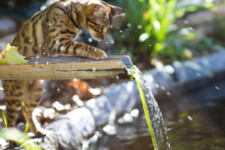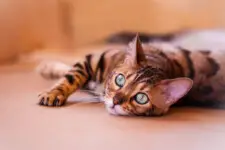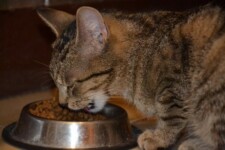All About Bengal Cats (The Wild Child Of Kitties!)
As of 2010, the International Cat Association reported that with 6369 registered cats, Bengal cats were the most registered, and their popularity continues to rise.
The physical appearance of a Bengal cat resembles that of their wild counterparts and the traits of a typical family cat.
The Bengal is the perfect cat for feline lovers looking for an exotic cat that comes in small size and without the danger posed by a wild cat. This cat comes in a marbled or spotted multi-colored coat.
The Bengal’s ability to form friendship with dogs is one of the traits that make them attractive.
Depending on the dog’s behavior around a Bengal, they can create long-lasting friendships.
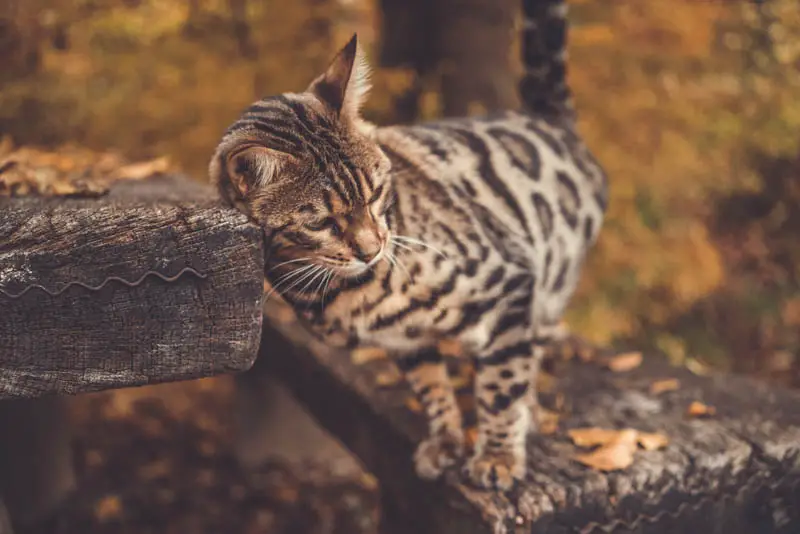
Our website is reader-supported through affiliate programs. If you purchase via links on our site we may earn a small commission.
The Origin Of Bengal Cats
The Bengal breed is a hybrid of an Asian leopard cat and a domestic cat.
Dr. Willard Centerwall started breeding domestic cats with Asian leopard cats in the 1960s and 70s in order to study their genetics.
He discovered they were immune to Feline Leukemia, and hoped that the discovery would be used in humans with weakened immune systems.
When he became sick, he gave his kittens to Jean Sudgen Mill, who promoted the new breed, and the international cat association accepted the breed for championship status in 1991.
Physical Attributes Of Bengal Cats
Coat Pattern
Bengal cats are the only domesticated cats that have the rosette markings.
They are often associated with brown spots, but they also come in different colors, marbles, and markings.
They can be ticked, red, spotted, brown, black, and clouded, and there are unique Bengal cats who resemble leopards.
Body Size
The body of Bengal cats ranges from medium to large but not as large as that of the biggest domestic cat breed. Their torso is long but not foreign and oriental.
Their masculinity, especially among male Bengals, is one of their distinguishing features, with their bone structure being firm and sturdy.
Bengal Cat Colors
Bengals appear in a number of different shades and markings:
- Seal mink tabby.
- Seal sepia tabby.
- Seal silver.
- Seal silver mink tabby.
- Seal silver lynx point.
- Seal lynx point.
- Brown tabby.
- Black silver tabby.
- Sepia tabby.
Tail
Their tail is of medium length, has a rounded tip, and is tapered at the end.
Ears
Bengal cat’s ears range from medium to small, fairly short, rounded tops, and broad at the base. They are located on the side as much as the top of the head.
Legs And Paws
Their legs are of medium length and slightly longer at the back. The feet are round, large, and have protruding knuckles.
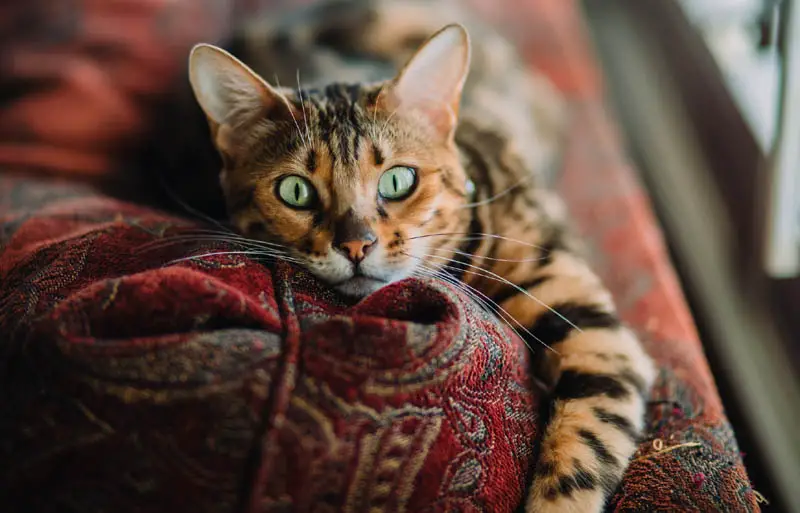
Lifespan and Health
Bengals typically live for about 12 to 16 years.
Responsible breeders make a point of avoiding genetic disorders and health complications, however it is essential to be aware of the conditions associated with Bengals.
They may suffer from flat-chested syndrome and distal neuropathy. The good news is, these conditions usually resolve on their own as the cat ages.
They may also develop patellar luxation, hip dysplasia, progressive retinal atrophy, and hypertrophic cardiomyopathy as they mature.
Bengal’s Personality
They are fun-loving, adventurous cats who require a lot of interaction and attention from their owners. They will do just about everything to get your attention.
They also enjoy hiding stuff, so ensure that you keep your items out of their reach, or you will spend hours looking for your shoes or favorite jewelry.
Bengals have a strong predatory nature owing to their genetic composition.
- They will hunt down small animals, so ensure that you keep hamsters, bunnies, mice, and other small pets out of their reach.
Prepare yourself to wake up to a dead bird or mouse occasionally.
These cats are amusing to live with, especially if you are an active person. They are talkative, attentive, and very confident. They enjoy playing games and often take part in a game of fetch.
The intelligence of Bengal cats is seen in their ability to learn tricks quickly, and the ability to come up with ways to entertain themselves in a dull environment. They enjoy learning new behaviors.
They are also nimble and athletic – Bengal cats enjoy climbing and tend to go for the highest point.
It is therefore quite crucial that you provide them with window parches and large cat trees to climb. If they are outdoors they willingly climb high trees.
Is your kitty being naughty? Find out some ways to correct your Bengal’s behavior patterns with positive reinforcement.
The Water Loving Cat
Bengal’s great love for water is something one should consider before bringing a Bengal cat home.
Do not be surprised if your cat decides to join you in the shower or tub!
Their love for water is attributed to their ancestors who were great fishers and hunters, and they might be tempted to go swimming in your pool.
Make sure you also keep the toilet lid down!
Did you know that Siberian cats also enjoy water? Check out our post taking a close look at Siberian cats to find out more.
Care and Grooming
Taking care of a Bengal is quite straightforward, with their coat requiring a weekly brush to get rid of dead hair and dander, and help spread natural skin oils.
To prevent periodontal disease ensure that you brush their teeth if possible on a daily basis.
Some cats are extremely adverse to you attempting to brush your teeth, so in this case your best option might be to give them dental care treats for cats, so they clean their teeth naturally while eating.
Remove any eye discharge by wiping the corners of their eyes using a damp and soft cloth.
Further, clean their ears using a soft cloth or a cotton ball containing an equal ratio of warm water and cider vinegar.
Keeping your Bengal indoors helps them avoid diseases spread by other cats and dogs, and also protects them from accidental risks, like being hit by a car.
Indoor cats generally live longer lives, however if your Bengal kitty is extremely active it might be hard to keep them in, but just ensure you keep them inside during the night to avoid them hunting small animals.
Ensure that your Bengal has ample space to play, jump, and climb. A Bengal’s nails should also be trimmed every few weeks to save your furniture from destruction.
The Family Friendly Cat
Bengal cats are ideal for families with friendly dogs and children, and will keep your children entertained and occupied by playing and learning tricks.
Bengals will also enjoy the attention they receive from your children, and they are a great match with the Bengal’s energy and curiosity.
Bengals are certainly not lap cats. They are action-oriented and require owners who can match their energy – people who understand their wild nature.
See More Of Our Cat Breeds Series
Find Out About Calico cats (The ‘Lucky Charm’)
Read About Tortoiseshell Cats (Tortie’s) – The Lucky Cat!
Cute Ginger Tabby Cats (What Makes Them Special?)
Have You Heard Of Lykoi Cats? (Little Warewolves!)
Sources
https://en.wikipedia.org/wiki/Flat-chested_kitten_syndrome
https://www.petmd.com/cat/conditions/musculoskeletal/c_ct_hip_dysplasia#

